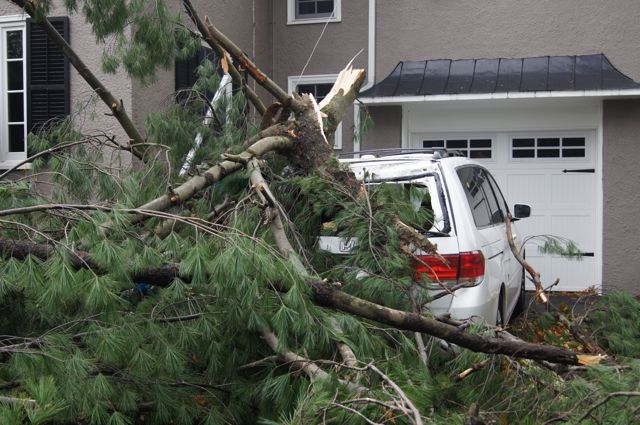The Wrath of Sandy and How to Deal With Her Aftermath
- Tuesday, 06 November 2012 15:16
- Last Updated: Tuesday, 06 November 2012 23:02
- Published: Tuesday, 06 November 2012 15:16
- Hits: 4262
 This article was contributed by Roz Binday, President of Advocate Brokerage in Scarsdale: We all know how badly Sandy battered the Scarsdale area, but there is a bright side. It was mostly a wind event…not a flood event. Even worse, it could have been both. Windstorms, hurricanes and Nor’Easters all have the potential to cause different kinds of damage over short distances due to many localized effects.
This article was contributed by Roz Binday, President of Advocate Brokerage in Scarsdale: We all know how badly Sandy battered the Scarsdale area, but there is a bright side. It was mostly a wind event…not a flood event. Even worse, it could have been both. Windstorms, hurricanes and Nor’Easters all have the potential to cause different kinds of damage over short distances due to many localized effects.
Understanding Your Deductibles: An important question that has now been answered is what was Sandy, a hurricane or a Nor’Easter? Those residents insured by carriers that mandate punishing hurricane deductibles would have been adversely affected if Sandy had been classified as a hurricane. It is common for carriers like Allstate and State Farm to have windstorm deductibles in the vicinity of 5% of the dwelling limit. For example, a house insured at $1,000,000 might have a $50,000 out of pocket windstorm deductible. Consequently, windstorm deductibles would have had a particularly devastating financial impact. Fortunately, Super Storm Sandy did not sustain hurricane winds, so it did not trigger the “special” windstorm deductible. People with “special” windstorm deductibles dodged the bullet this time.
This is a moot point for those insured with carriers like Chubb, Fireman’s Fund, PURE, ACE and Travelers, as they do not implement a special hurricane deductible in our territory. Damage from Sandy would always have been subject to only one base policy deductible.
Report Your Loss ASAP: When catastrophe strikes, those who have sustained damage or are in need of assistance should promptly report this to their insurer. In the interest of speed, insurance carriers promote and encourage direct claims reporting, which is why they have 24-7 800 numbers. These numbers are listed on the policy, call your agent, or find it on line. In the event of emergencies, insurance agencies like Advocate Brokerage provide a voice mail system which announces the telephone numbers of the various insurers. Start getting estimates for the repairs to determine if they are over the deductible.
Documentation: In the case of Sandy, the massive volume of claims, power outages and devastation has caused inordinate delays with the claim process. Adjusters are straining to keep up with the losses. If your damage is severe and emergency repairs are required to prevent further damage from ensuing, the insurance carriers anticipate and expect that emergency repairs will be made. It is strongly suggested that photographs be taken of the damages to be presented to the appointed adjuster. One picture can be worth a thousand words…and can avert a big headache!
Tree Removal and Loss of Refrigerated Goods: Coverage is usually subject to your base deductible and the limits afforded can vary dramatically from carrier to carrier. Check your policy or call your agent.
In summary: Just as all men are not created equal, so all policies are not created equal. Your insurance policy is a contract, and all coverage is determined by the terms, conditions, limitations and exclusions as set forth in the policy.
If a tree falls on my house, am I covered?
This is a question asked of us every time there is a major windstorm. It is also one of the most frequent questions the Insurance Information Institute (I.I.I.) receives from consumers each year. Consequently, we are attaching their generalized responses below in italics, as they are self-explanatory.
“The answer is quite straightforward,” said Jeanne M. Salvatore, senior vice president and consumer spokesperson for the I.I.I. “If a tree hits a home or other insured structure such as a detached garage, standard homeowners insurance policies provide coverage for the damage the tree does to the structure and the contents within it. This includes trees felled by a windstorm, hail, weight of ice, snow or sleet.”
Furthermore, it does not matter whether or not a tree was actually growing on your property; if it lands on your home, you should file a claim with your insurance company. After a hurricane or windstorm trees, shrubs and branches can become projectiles capable of traveling significant distances. Insurance companies do not waste time trying to locate exactly where the tree originally lived.
“In some situations where the felled tree was located on a neighbor’s property, the policyholder’s insurance company may try to collect from a neighbor’s insurance company in a process called subrogation. This sometimes occurs if the tree was in poor health or not properly maintained. If the insurer is successful, you may be reimbursed for the deductible,” says Salvatore.
If a tree hits an insured structure, there is also coverage for the cost of removing the tree, generally up to about $500 to $1,000, depending on the insurer and the type of policy purchased. If the fallen tree did not hit an insured structure, there is generally no coverage for tree debris removal; however, some insurance companies may pay for the cost of removing it if the felled tree blocks a driveway or a ramp designed to assist the handicapped.
Cars damaged or destroyed by falling trees are covered under the comprehensive portion of an auto insurance policy.
Roz Binday is president of Advocate Brokerage Corp. 820 Scarsdale Avenue, Scarsdale, 914-723-7100, rozbinday@advbc.com














